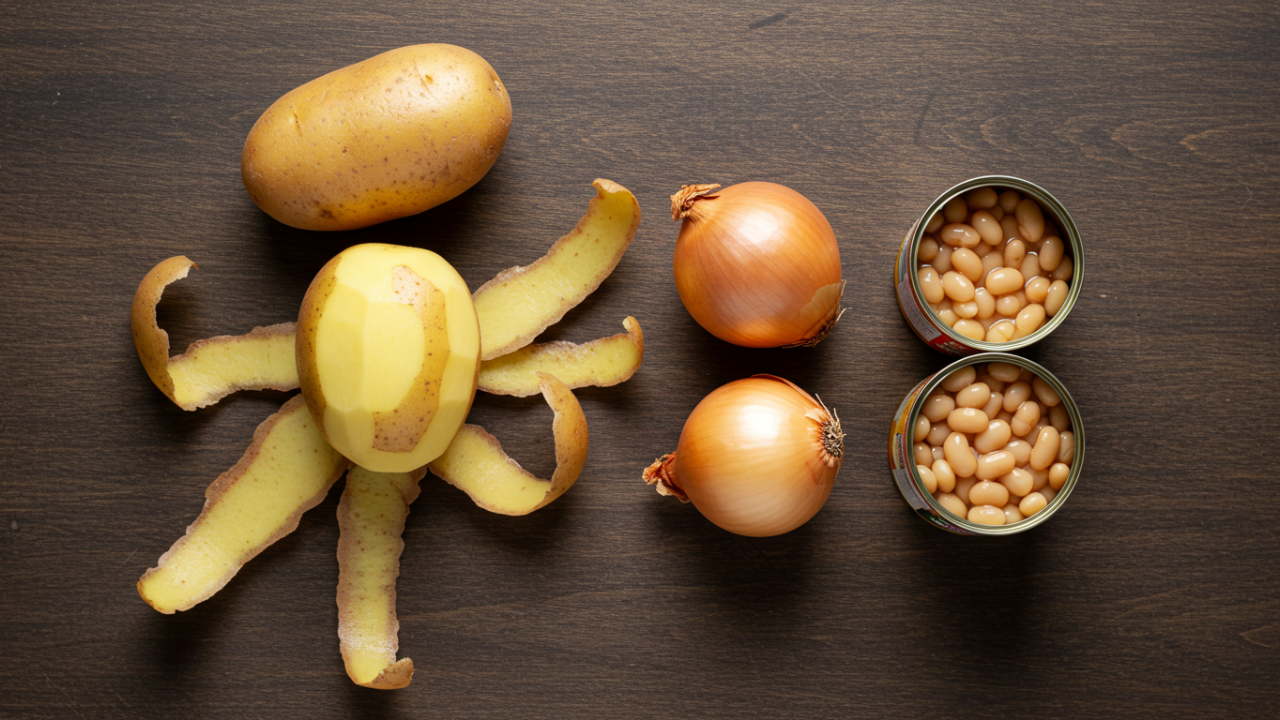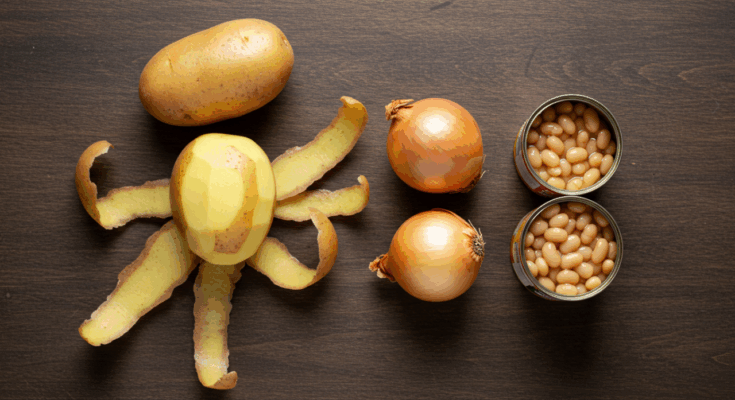In today’s fast-paced world, where grocery budgets stretch thin and time is a luxury, the art of turning everyday pantry items into extraordinary meals feels like alchemy. Simple staples—those unassuming ingredients like rice, beans, pasta, eggs, and canned tomatoes—often sit forgotten on shelves, waiting for inspiration. But with a dash of creativity and some foundational techniques, you can elevate them from mundane to magnificent, creating dishes that rival restaurant fare. This isn’t about splurging on exotic imports; it’s about maximizing what you already have, reducing waste, and building kitchen confidence. Whether you’re a busy parent, a budget-conscious student, or someone tired of takeout, this guide will equip you with practical strategies to transform basics into culinary gold. We’ll cover techniques, recipes, and tips that answer burning questions like “How do I make rice exciting?” or “What can I do with a can of beans besides chili?” By the end, you’ll have actionable ideas to experiment with tonight.
Embracing this approach not only saves money—staples cost pennies per serving—but also promotes sustainability by minimizing specialty purchases. Plus, it hones your intuition, turning cooking into a rewarding ritual. Let’s uncover how to mine gold from your pantry.
Identifying Your Kitchen Staples
Core Staples and Why They Matter
Simple staples are the building blocks of resilient cooking: affordable, long-lasting, and versatile. Common ones include grains (rice, oats, quinoa), legumes (beans, lentils, chickpeas), proteins (eggs, canned tuna, tofu), carbs (pasta, potatoes, bread), and basics (onions, garlic, canned tomatoes, oil, vinegar). These items store well—rice lasts years in a cool spot—and form the base of countless cuisines.
Why focus on them? In uncertain times, like supply chain disruptions or economic shifts, staples ensure you can always whip up a meal. Nutritionally, they’re powerhouses: Beans provide fiber and protein, eggs offer complete amino acids, and grains deliver sustained energy. The key to transformation lies in viewing them not as fillers but as canvases—rice absorbs flavors like a sponge, while eggs bind and enrich.

Sourcing and Storing for Maximum Potential
Stock up smartly: Buy in bulk from discount stores or co-ops to cut costs—dry beans at $1 per pound yield multiple meals. Opt for quality where it counts, like extra-virgin olive oil for its fruity depth. Storage tips: Keep grains in airtight jars to prevent pests; refrigerate opened cans in glass for up to a week. Rotate stock using FIFO (first in, first out) to avoid spoilage.
Question often asked: “How do I know if staples are fresh?” Sniff for off odors in oils (rancid = bitter) or check beans for weevils. Fresh staples mean better results, so audit your pantry quarterly.
Techniques for Elevation
Building Flavor Layers
The secret to turning staples golden is layering flavors—starting with aromatics, adding acids, and finishing with textures. Begin by sautéing onions and garlic in oil; this “sofrito” base infuses depth into any dish. For example, caramelize onions slowly (20-30 minutes on low heat) to unlock sweetness that elevates plain rice.
Incorporate umami: Mash canned anchovies (if available) or use soy sauce to amplify savoriness in bean stews. Acids like vinegar or lemon juice brighten heaviness—add a splash to pasta water for tang. Herbs and spices are game-changers; even basic cumin or paprika can transport rice to Moroccan vibes. Actionable: Create a “flavor kit” with salt, pepper, chili flakes, and dried herbs—start with 1/4 teaspoon per serving and taste as you go.
Mastering Texture Transformations
Texture turns bland into brilliant. Roast staples for crunch: Toss chickpeas with oil and spices at 400°F for 25 minutes to make crispy snacks. Puree beans into creamy dips with a blender or fork. For eggs, poach in simmering water for silky yolks or whip into fluffy omelets.
Fermentation adds complexity—quick-pickle onions in vinegar for 10 minutes to top tacos. Grilling or broiling creates char: Blacken potatoes under the broiler for smoky skins. Insight: Contrast textures—pair creamy mashed potatoes with crunchy toppings like toasted nuts—to make meals engaging.
Heat and Timing Essentials
Heat control is alchemy’s fire. Low and slow for beans builds tenderness (simmer 1-2 hours); high and quick for pasta al dente (boil 8-10 minutes). Use residual heat: Let rice steam off-burner for fluffiness. Common pitfall: Overcooking turns gold to mush—set timers but check doneness by taste and touch.
Recipes: From Basic to Brilliant
Golden Rice Pilaf with Variations (Serves 4, Prep: 30 mins)
Start with 1 cup rice—rinse to remove starch for separate grains. Sauté 1 chopped onion in 2 tbsp oil until golden. Add rice, toasting 2 minutes for nutty flavor. Pour in 2 cups broth (or water with a bouillon cube), simmer covered 15-18 minutes. Fluff and mix in extras: For Mediterranean gold, add chickpeas, feta, and olives. Mexican twist: Stir in canned tomatoes, cumin, and corn. Insight: This base answers “How to avoid boring rice?” by absorbing whatever’s on hand—frozen veggies or leftover proteins.
Elevated Bean Burgers (Serves 4, Prep: 20 mins + chill)
Drain and mash 2 cans black beans with a fork, leaving chunks for texture. Mix in 1/2 cup oats (ground if needed), 1 egg (or flaxseed slurry for vegan), minced garlic, cumin, and salt. Form patties, chill 15 minutes to firm. Pan-fry in oil 4-5 minutes per side until crispy. Serve on bread with pickled onions and yogurt sauce. Value: These outshine store-bought, cost under $2 per serving, and freeze well. Customize: Add cheese for melt or spices for heat.
Pasta Primavera Reinvented (Serves 4, Prep: 25 mins)
Boil 400g pasta in salted water. In a pan, sauté garlic and onions, add canned tomatoes for sauce base. Toss in staples like frozen peas or canned artichokes. Finish with olive oil drizzle and grated cheese (or nutritional yeast). Pro tip: Reserve pasta water to emulsify sauce—adds silkiness without cream. This flexible recipe tackles “What to do with plain pasta?” by layering seasonal or pantry add-ins.
Egg-cellent Shakshuka (Serves 2, Prep: 25 mins)
In a skillet, simmer canned tomatoes with onions, garlic, cumin, and paprika for 10 minutes. Crack 4 eggs into wells, cover, and poach 5-7 minutes for runny yolks. Serve with bread. Transformation: From basic eggs to North African gold. Adapt for one: Halve portions. Nutritional boost: Eggs provide 12g protein per serving.
Potato Gnocchi from Scratch (Serves 4, Prep: 45 mins)
Boil 4 potatoes until tender, mash hot (no lumps). Mix with 1.5 cups flour and 1 egg, knead gently into dough. Roll into ropes, cut 1-inch pieces, boil until floating (2 minutes). Toss in simple sauce: Butter and sage, or tomato. Insight: No fancy tools needed—fork for ridges. Answers “How to fancy up potatoes?” with pillowy results.
These recipes are scalable, use minimal tools, and encourage swaps—e.g., quinoa for rice in pilaf for gluten-free.
Advanced Tips and Troubleshooting
Experimentation Strategies
To go beyond recipes, use the “rule of threes”: Pick a staple, add one flavor (spice), one texture (crunchy top), one acid. Taste iteratively—adjust mid-cook. Build a “staple swap chart”: Rice = quinoa, beans = lentils. Seasonal tweaks: Summer herbs for freshness, winter roots for heartiness.
Sustainability angle: Repurpose leftovers—rice into fried rice, beans into salads. Batch cook staples weekly for quick assemblies.
Avoiding Common Pitfalls
Undersalted? Season in layers. Soggy textures? Pat dry before cooking. Burnt flavors? Stir frequently on medium heat. If staples taste flat, it’s often missing acid—squeeze lemon. For allergies, swap eggs with aquafaba (bean liquid). Budget tip: Grow herbs on a windowsill for free upgrades.
Mindfulness in cooking: Engage senses—listen for sizzles, smell for readiness—to turn routine into gold.
FAQ
What if my pantry is bare—where do I start?
Begin with five essentials: Rice, beans, eggs, canned tomatoes, onions. Build from there with weekly additions like spices.
How can I make these dishes kid-friendly?
Soften spices, add cheese for familiarity, and involve kids in assembly—like shaping bean burgers—to encourage trying new things.
Are these transformations healthy?
Yes, staples are nutrient-dense. Focus on portions: Balance carbs with proteins/veggies. For low-carb, swap rice for cauliflower.
What tools do I need beyond basics?
A good knife, cutting board, and one pot/skillet suffice. No blender? Mash by hand.
How do I store transformed dishes?
Refrigerate up to 3-4 days in airtight containers. Freeze portions for months—thaw overnight.
Can I scale for meal prep?
Absolutely—double recipes, portion into containers. Rice pilaf reheats well with a splash of water.
What if I’m vegan?
Swap eggs with tofu or chia seeds, dairy with plant alternatives. Beans shine as stars.
Word count: Approximately 1510. With these insights, your kitchen becomes a lab of delicious possibilities—start small, savor the process, and watch simple staples gleam.



